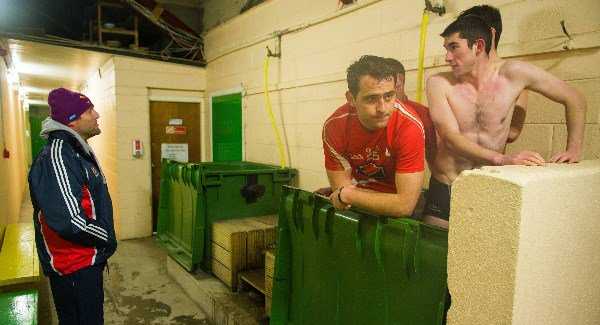This week the GAA issued guidelines for appropriate and safe training for Gaelic games. We asked Michael Moynihan to decode those guidelines to find out if they’re an improvement on the old regime, and whether some carry a deeper message.
The GAA’s Player Conference throws in today in Croke Park, with a range of speakers addressing issues affecting player preparation and fitness. It follows on from the guidelines issued jointly during the week by the GAA’s Medical, Scientific and Welfare (MSW) and National Games Development (NGD) Committees.
A quick look at those guidelines shows the pitfalls facing GAA teams all over Ireland: they want to use best practice, but some of the practices highlighted in the guidelines can be counter-productive, to say the least.
Cryotherapy
Guidelines: There is insufficient evidence at present to support the use of whole-body cryotherapy (WBC) and cold water immersion (ice-baths).

Louth players go through the post-match ice bath routine following their clash against Meath at Páirc Táilteann, Navan. Picture: Stephen McCarthy.
True enough. Though many international rugby teams have been using cryotherapy chambers for some years, the (scientific) jury is still out on their efficacy.
This hasn’t prevented some unfortunate errors among GAA clubs eager to show they’re at the cutting edge of athlete recovery, though with cold water immersion rather than chambers which go to minus-140 degrees.
The best example is the All-Ireland senior medallist who was keen to show the way with his own club and duly hopped into a wheelie bin full of ice water. Unfortunately he misread the instructions — 30 seconds in, two minutes out, 30 seconds back in — and instead spent the full two minutes in the freezing water.
He had to be lifted out after three sessions because his legs had gone numb. A little learning can be a dangerous thing.
Military-style team building activities
Guidelines: In general, team building activity days can provide a positive benefit . . . However, more extreme activities… risks to players such as exhaustion, pneumonia.
Health isn’t the only risk when bringing a GAA team to a remote location for team-building. It can backfire badly, as more than one manager can attest. Sometimes the bainisteoir’s authority can get a beating.
Exhibit A is the example given by Tomás Ó Sé in his autobiography. When then-manager Jack O’Connor brought Ó Sé and his Kerry teammates for a long mountain walk near Killarney the Gaeltacht man and a couple of accomplices hopped in a car and spared their legs.
Exhibit B is the famous story of the Limerick hurlers of the nineties being brought away for an overnight boot camp to build spirit.
One of their army instructors did press-ups with the backs of his hands to show the level of toughness required. His standing was a little undercut by Mike Houlihan, who casually rattled off 20 press-ups using the same method.
Anti-doping
Guidelines: If supplements are being provided to adult players, only supplements which have been recommend for the player by a qualified sports dietician/nutritionist.
While everyone is aware of the GAA players who have failed drugs tests, fewer are familiar with the ramifications of having the people wearing those Irish Sports Council lanyards turn up at a dressing-room door.
Their appearance caused consternation after an inter-county championship game some years ago when — as is the custom — they asked for two randomly selected players, identifying them solely by their jersey numbers.
One submitted willingly, but the other would not accede to the test under any circumstances.
After some delicate negotiations, the testers explained that they weren’t looking for recreational substances, but the stand-off was never resolved, and the player went untested.
Dehydration
Guidelines: Players are encouraged to bring their own water bottles and should be given multiple opportunities to take on water during a session.
This development may seem superfluous in an age when even primary-school children seem to go everywhere with a water bottle in their hands, but it’s no harm to remind ourselves of a time when drinking water wasn’t so much an optional extra but regarded as actively harmful.
In his autobiography, Justin McCarthy recalls the day in the sixties when he and some teammates ran a hurling camp for kids in Cork the week of a Munster championship game.
A baking hot high summer, but not a drop of water passed their lips. It wasn’t felt at the time that there was any benefit to taking on fluids, which goes to show that what’s believed to be healthy for one generation may not be written in stone.
On an incidental note, while nutrition is addressed generally by the guidelines’ references to the work of qualified nutritionists and dietitians, the move towards healthy fuelling foods has had an impact on those feeding elite intercounty teams in particular.
A caterer whose establishment has a long history of providing lunches and dinners for the top sides has been loud in his complaints in recent years about the lack of profit in providing vast bowls of pasta and chicken to county teams compared to what are now known as the “good old days” when 40 orders of steak and chips was the norm when a team came through the front door.
There’s the cloud that comes with the silver lining.
Concussion
Guidelines: If a player suffers a collision or impact which could result in a potential concussion, a coach should remove the player from play/training and not allow to return on the same day.
This is a welcome development given a) the seriousness of concussion as an injury and b) a concomitant tendency to refer to it almost as a badge of honour, a tendency which is now well and truly on its last legs.
Before it faded, this tendency generated plenty of stories which provided a good laugh as long as you weren’t the central character: the mainstay was a yarn about a player in the Munster hurling championship who shipped a heavy knock and didn’t know where he was at half-time, with the manager sending him back out on the basis that that was when he was at his best.
With the frightening data emerging from American football and rugby, this is one guideline whose time has well and truly arrived.
Injury prevention
Guidelines: Registered players have coverage by GAA club injury insurance. Players should make sure they are paid up members of their club.
An odd insertion to some readers, though one can’t help but wonder if this section of the guidelines is a coded reference to the widely-held belief that participants in other sports sometimes bring injuries sustained in those sports to the GAA field.
The reason for this is the GAA’s much-admired injury cover scheme which, anecdotally, has looked after more than a few hamstring pulls and calf strains picked up while pursuing a non-O’Neill’s ball.
Some years ago a GAA official told this writer that with a scheme like the GAA’s a certain amount of marginal claims have to be expected.
Is there a subtle warning in the guidelines about cutting that amount down, however?
This story first appeared in the Irish Examiner.
Sourse: breakingnews.ie






